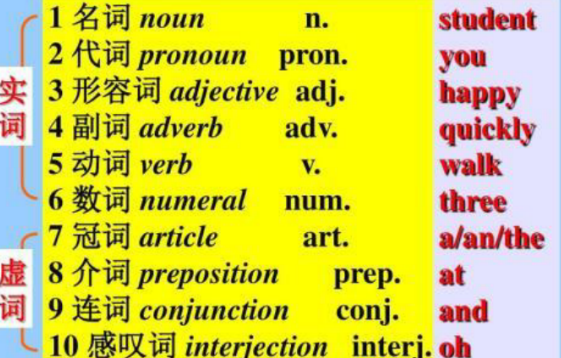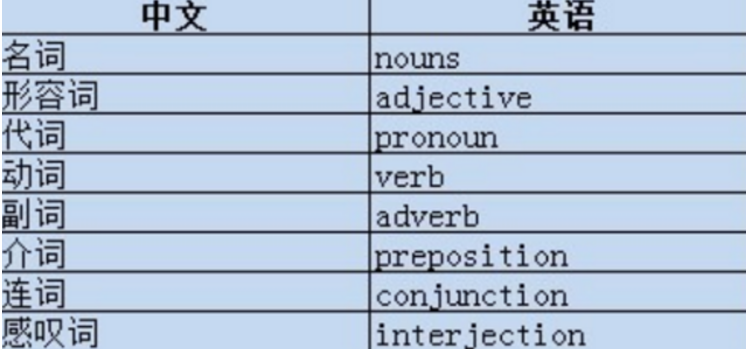[卫生间中用到的各个物品的英文名称是什么]通便器:plunger 抽水马桶:toilet 水箱:toilet tank 马桶座:toilet seat 空气清洁器:air freshener 卫生纸架:toilet paper holder 马桶刷:toilet brush 浴巾架:towel rack 浴巾:bath...+阅读
英语里面各个语法名称的英文要详细和正规会追加分哦
Traditional grammar classifies words based on eight parts of speech: the verb, the noun, the pronoun, the adjective, the adverb, the preposition, the conjunction, and the interjection.Books are made of ink, paper, and glue. In this sentence, "books" is a noun, the subject of the sentence.Deborah waits patiently while Bridget books the tickets. Here "books" is a verb, and its subject is "Bridget."We walk down the street. In this sentence, "walk" is a verb, and its subject is the pronoun "we."The mail carrier stood on the walk. In this example, "walk" is a noun, which is part of a prepositional phrase describing where the mail carrier stood.The town decided to build a new jail. Here "jail" is a noun, which is the object of the infinitive phrase "to build."The sheriff told us that if we did not leave town immediately he would jail us. Here "jail" is part of the compound verb "would jail."They heard high pitched cries in the middle of the night. In this sentence, "cries" is a noun acting as the direct object of the verb "heard."The baby cries all night long and all day long. But here "cries" is a verb that describes the actions of the subject of the sentence, the baby.The next few sections explain each of the parts of speech in detail. When you have finished, you might want to test yourself by trying the exercise.
英语词性缩写有哪些
词性指以词的特点作为划分词类的根据。常见的英语词性缩写:名词n;动词v;形容词adj;副词adv;介词prep;代词pron等。

词性指以词的特点作为划分词类的根据。从组合和聚合关系来说,一个词类是指∶在一个语言中,众多具有相同句法功能、能在同样的组合位置中出现的词,聚合在一起形成的范畴。词类是最普遍的语法的聚合。词类划分具有层次性。常见的英语词性缩写:名词n;动词v;形容词adj;副词adv;介词prep;代词pron等。

名词:Nouns(n.)表示人或事物的名称box, pen,tree,apple。代词:Pronouns(pron.)代替名词、数词、形容词We, this, them,myself。形容词:Adjectives(adj.)用来修饰名词,表示人或事物的特征good, sad, high, short数词:Numerals(num.)表示数目或顺序。

动词:Verb(v.)表示动作或状态Jump,sing,visit。副词:Adverbs ( adv.)修饰动、形、副等词,表示动作特征there,widely suddenly。冠词:Articles (art.)用在名词前,帮助说明名词所指的范围a, an, the。介词:Prepositions(prep.)用在名词或代词前,说明它与别的词的关系in,on,down,up。连词:Conjunctions (conj.)表示人或事物的名称if,because,but。感叹词:Interjections (int.)代替名词、数词、形容词等oh,hello,hi,yea。
英语单词后面的词性代号比如名词:n
n. 名词 v. 动词 pron. 代词 adj. 形容词 adv. 副词 num.数词 art. 冠词 prep. 介词 conj. 连词 interj. 感叹词 英语词性缩写 prep = 介系词;前置词,preposition的缩写 pron = 代名词,pronoun的缩写 n = 名词,noun的缩写 v = 动词,兼指及物动词和不及物动词,verb的缩写 conj = 连接词 ,conjunction的缩写 s = 主词 sc = 主词补语 o = 受词 oc = 受词补语 vi = 不及物动词,intransitive verb的缩写 vt = 及物动词,transitive verb的缩写 aux.v = 助动词 ,auxiliary的缩写 adj = 形容词,adjective的缩写 adv = 副词,adverb的缩写 art = 冠词,article的缩写 num = 数词,numeral的缩写 int = 感叹词,interjection的缩写 u = 不可数名词,uncountable noun的缩写 c = 可数名词,countable noun的缩写 pl = 复数,plural的缩写 语气词 int. 缩写词 abbr. abbr abbreviation(略)略语 adj, adjjadjective(s)(形)形容词 adv, advvadverb(s)(副)副词 adv partadverbial particle(副接)副词接语 aux auxiliary(助)助动词 cn countable noun(可数)可数名词 conj conjunction(连)连接 def art definite article(定冠)定冠词 egfor example(例如)例如 esp especially(尤指)尤指 etc and the others(等)等等 ie which is to say(意即)意即 indef art indefinite article(不定冠词)不定冠词 inf infinitive(不定词)不定词 int interjection(感)感叹词 n noun(s) (名)名词 neg negative(ly)(否定)否定的(地) part adj participial adjective(分形)分词形容词 pers person(人称)人称 pers pron personal pronoun(人称代)人称代名词 pl plural(复)复数(的) pp past participle (过去分词)过去分词 pref prefix(字首)字首 prep preposition(al) (介词)介词,介系词,介词的 pron pronoun (代)代名词 pt past tense(过去)过去式 sb somebody(某人)某人 sing singular(单)单数(的) sth something(某事物)某物或某事 suff suffix(字尾)字尾 un uncountable noun(不可数)不可数名词 US America(n)(美)美国(的) vverb(s) (动)动词 [VP]Verb Pattern(动型)动词类型 v iverb intransitive(不及物动词)不及物动词 vt verb transitive (及物动词)及物动词 除这十大类词之外,英语还另有判断词yes和no。
vi不及物动词 vt及物动词
英语感叹词
感叹词是用来表示说话时表达的喜怒哀乐等情感的词。它不构成后面句子的一个语法成分,却在意义上与它有关连,后面的句子一般说明这种情绪的性质、原因。感叹词是英语口语中最富于表现力的词语之一,用途甚广。学会它,对于提高英语的交际能力,表达复杂的思想起着举足轻重的作用。英语中的感叹词很多,但目前的语法著作中却很少对它进行归纳总结,致使许多人对含有感叹词的句子理解不透。现将部分感叹词的用法进行小结:
一、Oh 表示惊讶、指责、痛苦、称赞、懊恼等,可译为“哦”、“哎呀”、“噢”“啊”、“呀”等。 1. "Oh, who was that?" Mr. Black asked.“哦,是谁?”布莱克先生问。 2. "Oh, how blind you are!" he cried.“哎呀,你们真瞎!”他大声道。 3. "Oh, oh!" he cried. "My stomach! My head! oh! oh!“哎呀,哎哟!”他大声道,“我的肚子!我的头!哎哟!哎哟!” 4.Oh, learned judge! Oh, wise young man. 噢,博学的法官!噢,聪明的年轻人!
二、Ah表示惊奇、高兴、讨厌、懊悔、藐视、威胁等,可译为“呀、啊”等。 1. Ah, yes, Jeanne married a man with a lot of money. 啊,对啦,让娜嫁给了一个很有钱的人。 2. "Ah, what splendid clothes!" thought the Emperor.“啊!多华丽的衣服啊!”皇帝想。 3. Ah, how pitiful! 呀,多可惜! 4. Ah, here is the thing I am after. 哎呀,我找的东西在这儿呢。
三、come表示鼓励、不耐烦、引起注意、安慰等,可译为“喂、好吧、说吧、得啦”等。 1.Oh, come, Mathilde. Surely you can tell an old friend. 嗨,说吧,玛蒂尔德,你对老朋友说说总是可以的吧。 2.Come, we must hurry. 喂,我们得赶紧啦! 3.Come, come, get him his change. Tod, get him his change. 好吧,好吧,托德,快把钱找给他,快把钱找给他。 4. Come, come! What were you really doing behind the bicycle sheds? 喂!喂!你还在车棚里磨蹭啥?
四、dear表示后悔、难过、怜悯、同情、吃惊、盼望等,可译为“哎呀、天哪”等。 1. Dear m! What awful weather! 哎呀! 多糟的天气! 2. Oh, dear, dear! Where can Harry be? 天哪,天哪,亨利会在哪儿? 3. Dear, dear! Where have I put my keys? 哎呀,我把钥匙放在哪啦? 4. "Dear me," he said to himself, "Am I foolish or unfit for my office?" "哎呀!"他心里嘀咕着,“我是愚蠢呢还是不称职?”
五、well表示快慰、让步、期望、讥讽、解释、责备、犹豫等,可译为“好吧、不过、好啦、嗯”等。 1. Well, your father has found him in the garage. 好啦,你父亲在车库里找到他了。 2. Are you sure? Wel, perhaps you, are right. 你能肯定吗?嗯,也许你说得对。 3. Well, you must come to lunch tomorrow. 不过,你明天一定要来吃午饭。 4. I handed the note to him and said, "Oh, very well, I apologize." 我把那张票子递给了他,说道:“啊,好极了,我向你道歉。” 5. Well, why don't you make a notice like theirs? 那么,你为什么不做个像他们那样的广告牌呢?
六、now 表示警告、命令、请求、说明、安慰筹,可译为“喂、喏、好了”等,有时也可不必译出。 1. Now, now, you two; Don't fight again. 喂,喂,你们俩,别再打了。 2. Now, now, my boy! It's all right! There's no need to cry! 好了,好了,孩子,没事了,别哭了。 3. Now, let's play basketball. 喏,咱们打篮球吧! 4. Now, lift me up, Doctor, lift me up. Where is he? 把我扶起来吧,医生,把我扶起来。他在哪里?
七、there表示得意、鼓励、同情、悲哀、不耐烦、失望、安慰、挑衅、引起注意等,可译为“哟、瞧、好啦、得啦”等。 1.There! There! Never mind, you'll soon feel better. 好啦,好啦,不要紧,你马上会好的。 2. Thefe, there, you said too much. 得啦,得啦,你说的太多了。 3.There, I've filled it up again.瞧,我又把它灌满了。 4.There, what's that?哟,那是什么!
八、man表示兴奋、轻蔑、不耐烦、引起注意、可译为“啊、嗨”等。 1."Use you knife, man!" ordered the British officer nearby.“嗨,用刀子割!”旁边的英国军官命令道。 2. Hurry up, man. 嗨,快点。 3. We have won the match, man!啊,我们胜利了。
九、boy表示高兴、兴奋、惊奇等,可译为“嘿、哇、哼、怎么样”等。 1. Boy, oh, boy! Our team's going to win! How fantastic? 哇,怎么样!我们队要赢了!真是太好了! 2.Boy! This soup is good, Mama! 嘿,妈妈,这汤好得很。 3.Oh, boy! I just had a wonderful dream! 嘿,我刚才做了个好梦。
十、此外还有: ha(惊奇、疑惑、鄙视) Ha! Pround as these nobles are, he is afraid to see me. 哈!这些贵族尽管傲慢,他却害怕见到我。 aha(得意、惊奇、嘲弄、满意) The trousers are all right; now the waistcoat; aha, right again.裤子合身;再请穿上背心试试;啊哈,也很合适。 hey(喜悦、打招呼) Hey! I didn't expect to meet you here. 嗨,我没想到会在这儿遇到你。 sh(制止、引起注意) They were about to go down. When Tum suddenly whispered. "...
延伸阅读:
高考报志愿的详细步骤详细的!详细的加分!掌握全面信息,填好高考志愿 以一个健康务实的心态为基础,填报高考志愿就成功了一半,但填报志愿不可大意,有一些技巧,下面从几个具体细节详述。 填好第一志愿 第一志愿是志愿填报...
美国留学课程描述商务英语专业要中英文的以下是课程名称基础英语1-4Essential English 1-4 (essential是根本的,必要的意思)Basic English 商务函电Foreign Economic Contract Documents in WritingBusiness Letters 国际经济英语...
word里面正规文档的排版格式正文排版规范,WORD排版除符合下述第1)项的一般常用规范外,还应遵循第2)项的各项规范。供参考: 1)一般常用规范 这里以16开图书的版式作简要说明。版式可以活泼多样,根据需要,还可以...
详细的英语语法有几种首先心理上不能惧怕语法,另外不要认为语法是复杂令人学不会的东西。 其实英语语法不是很多的,经过不断的积累,到了高中结束大部分语法已经学完。 你可以买本语法书,遇到不懂的地...
其乐融融是什么意思要详细哦新手没有悬赏请见谅解释〗 其:代词,其中的;融融:和乐的样子。形容十分欢乐、和睦。 〖出处〗 《左传·隐公元年》:“公入而赋:‘大隧之中,其乐也融融。’” 〖典故〗 颍考叔曰:“敢①问何谓②也?”公语...
高考加分的乐器要具体具体到名称那种各学校因要求不同不一定全部招收。凡有交响乐团的话,弦乐:小提琴、中提琴、大提琴、低音提琴、竖琴(需求较少);管乐:长笛、短笛、双簧管、单簧管(黑管)、巴松管(大管)、圆号、小号、长...
电脑主机的结构和各个硬件的名称机箱,一般来说左侧面板可以很容易拆卸,方便零部件装入 电源,装在机箱内部,一般在机箱后上部 主板,机箱内部,由几个螺钉固定在机箱内部的螺丝柱上 CPU,装置在主板上CPU的专用位置上...
各个银行的英文名称是什么各个银行的英文名称是什么,全国所有银行的英文名称:中国人民银行 People's Bank of China 中国银行 Bank of China 中国工商银行 Industrial and Commercial Bank of China 中...
求首歌的名字。。。要写出歌词和歌手哦。求首歌的名字。。。要写出歌词和歌手哦,我想和你回到当初的模样你是不是我深爱的姑娘是什么歌啊:欢子 t.r.y -永远不分开 词曲:欢子(fandy) 专辑:愚爱 女:认识你是个意外 你让我每...





